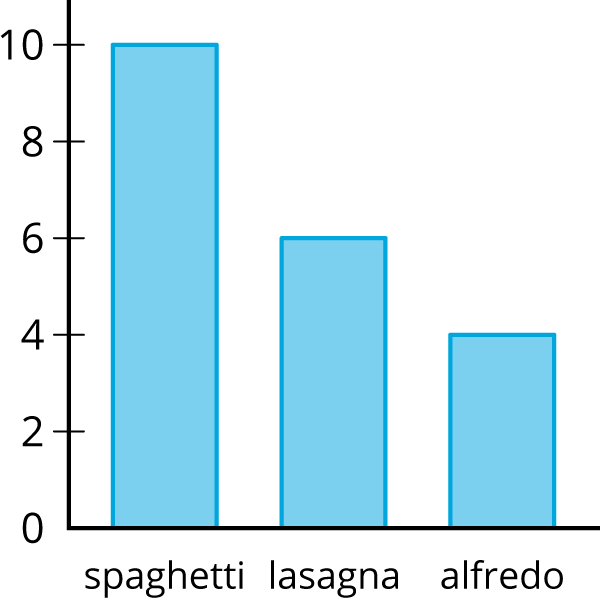Lesson 16
Estimating Population Proportions
Problem 1
Tyler wonders what proportion of students at his school would dye their hair blue, if they were allowed to. He surveyed a random sample of 10 students at his school, and 2 of them said they would. Kiran didn’t think Tyler’s estimate was very accurate, so he surveyed a random sample of 100 students, and 17 of them said they would.
-
Based on Tyler's sample, estimate what proportion of the students would dye their hair blue.
-
Based on Kiran's sample, estimate what proportion of the students would dye their hair blue.
-
Whose estimate is more accurate? Explain how you know.
Solution
For access, consult one of our IM Certified Partners.
Problem 2
Han surveys a random sample of students about their favorite pasta dish served by the cafeteria and makes a bar graph of the results.

Estimate the proportion of the students who like lasagna as their favorite pasta dish.
Solution
For access, consult one of our IM Certified Partners.
Problem 3
Elena wants to know what proportion of people have cats as pets. Describe a process she could use to estimate an answer to her question.
Solution
For access, consult one of our IM Certified Partners.
Problem 4
The science teacher gives daily homework. For a random sample of days throughout the year, the median number of problems is 5 and the IQR is 2. The Spanish teacher also gives daily homework. For a random sample of days throughout the year, the median number of problems is 10 and the IQR is 1. If you estimate the median number of science homework problems to be 5 and the median number of Spanish problems to be 10, which is more likely to be accurate? Explain your reasoning.
Solution
For access, consult one of our IM Certified Partners.
(From Unit 8, Lesson 15.)Problem 5
Diego wants to survey a sample of students at his school to learn about the percentage of students who are satisfied with the food in the cafeteria. He decides to go to the cafeteria on a Monday and ask the first 25 students who purchase a lunch at the cafeteria if they are satisfied with the food.
Do you think this is a good way for Diego to select his sample? Explain your reasoning.
Solution
For access, consult one of our IM Certified Partners.
(From Unit 8, Lesson 14.)